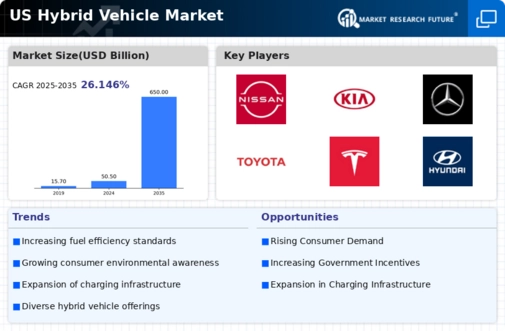The hybrid vehicle market in the US is currently characterized by a dynamic competitive landscape, driven by increasing consumer demand for fuel-efficient and environmentally friendly transportation options. Key players such as Toyota (Japan), Ford (US), and Hyundai (South Korea) are at the forefront, each adopting distinct strategies to enhance their market presence. Toyota (Japan), known for its pioneering role in hybrid technology, continues to focus on innovation and sustainability, while Ford (US) emphasizes electrification and expanding its hybrid offerings. Hyundai (South Korea) is leveraging partnerships and technological advancements to enhance its hybrid vehicle lineup, collectively shaping a competitive environment that prioritizes eco-friendly solutions and technological integration.
In terms of business tactics, companies are increasingly localizing manufacturing and optimizing supply chains to enhance efficiency and reduce costs. The market structure appears moderately fragmented, with several key players exerting influence over various segments. This fragmentation allows for a diverse range of hybrid offerings, catering to different consumer preferences and price points, while also fostering competition among established and emerging brands.
In October 2025, Ford (US) announced a strategic partnership with a leading battery technology firm to enhance its hybrid vehicle performance and sustainability. This collaboration is expected to significantly improve battery efficiency and reduce production costs, positioning Ford to better compete in the rapidly evolving hybrid market. The strategic importance of this move lies in Ford's commitment to electrification, which aligns with broader industry trends towards sustainable transportation solutions.
In September 2025, Toyota (Japan) unveiled its latest hybrid model, which incorporates advanced AI technology for improved driving efficiency and user experience. This launch not only reinforces Toyota's leadership in hybrid technology but also highlights the company's focus on integrating digital solutions into its vehicles. The introduction of AI-driven features is likely to attract tech-savvy consumers, further solidifying Toyota's competitive edge.
In November 2025, Hyundai (South Korea) revealed plans to expand its hybrid vehicle production capacity in the US, aiming to meet the growing demand for eco-friendly vehicles. This strategic expansion is indicative of Hyundai's proactive approach to capturing market share and responding to consumer preferences. By increasing production capabilities, Hyundai positions itself to leverage economies of scale and enhance its competitive standing in the hybrid vehicle segment.
As of November 2025, current competitive trends in the hybrid vehicle market are increasingly defined by digitalization, sustainability, and the integration of AI technologies. Strategic alliances among key players are shaping the landscape, fostering innovation and enhancing product offerings. Looking ahead, competitive differentiation is likely to evolve from traditional price-based competition to a focus on technological innovation, supply chain reliability, and sustainability initiatives. This shift underscores the importance of adapting to consumer expectations and regulatory requirements in a rapidly changing market.


























Leave a Comment